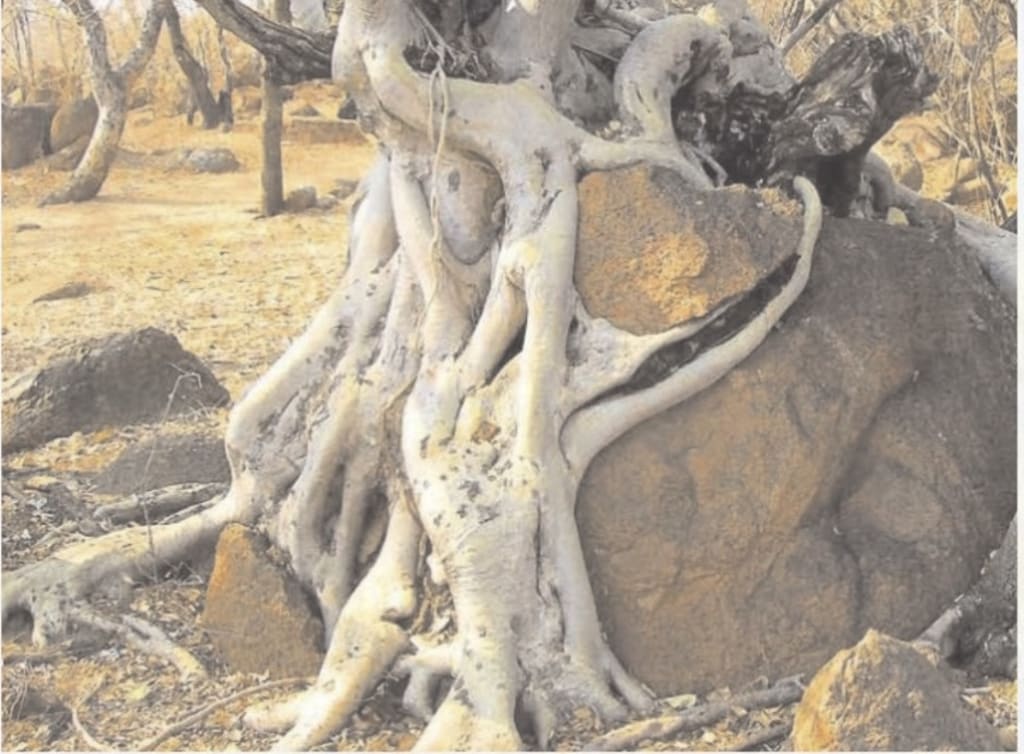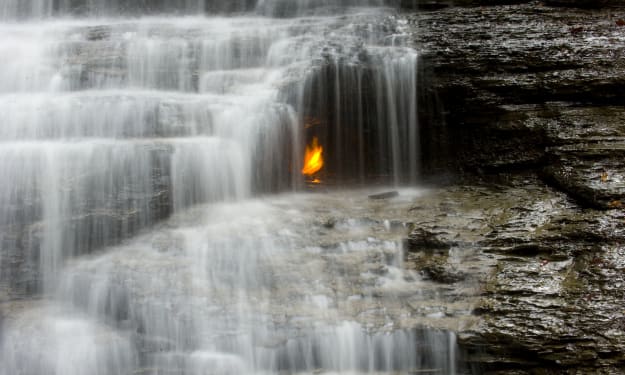Biological Weathering
Biological weathering by physical means occurs when a force or pressure is applied to break rocks or degrade the minerals in them. Plants can grow anywhere and can biologically weather rocks by growing into the cracks.

Did you ever wonder where the soil beneath your feet comes from? The answer is rocks. Rocks become disintegrated and broken into smaller particles by a process called weathering. The elements from the weathered rocks provide nutrients for plants and animals. Biological weathering may take place either by physical or by chemicals means.
Biological weathering by physical means occurs when a force or pressure is applied to break rocks or degrade the minerals in them. Plants can grow anywhere and can biologically weather rocks by growing into the cracks.
Burrowing animals like shrews. moles, earthworms, and ants contribute to biological weathering. They make holes in the ground and move the rock fragments to the surface. Birds, while foraging for seeds and worms create holes and erode the upper surface of the soil, thus contributing to weathering.
Humans can also indirectly contribute to biological weathering by merely walking and running, thus making the soil particles crushed into smaller pieces. Tree plantation and road construction can also contribute to biological weathering.
Biological weathering by chemical means is also carried out by living organisms. This is also called organic weathering. Despite their minute size, some microorganisms can break down the largest rocks and the hardest soil. Such ativities are carried out by lichens and fungi. Fungi are well suited as weathering agents since they can be highly resistant to extreme environmental conditions such as metal toxicity, UV radiation, and desiccation. Many fungi can scavenge nutrients from the air and rain water which enables them to grow on rock surfaces.
In limestone, fungi and lichens are considered to be important agents of mineral deterioration. The bacteria Actinomycetes, through acid production, mineral solubilisation, and metal leaching have successfully degraded rocks. Actinomycetes inhabiting granite rocks at St. Catherine in Egypt were investigated for their bio-weathering potential. Actinomycetes counts ranged between 174 and 360 colony-forming units per gram.
Rock borers occur in a broad range of taxonomic groups including bivalves, gastropods, polychaetes, sipunculids, crustaceans, sea urchins, and sponges.
A new anatomically and morphologically divergent species of shipworm by name Lithoredo abatanica (Bivalvia) is found in Abatan River of the Philippines, that bores in carbonate limestone rather than woody substrates. It bores by ingesting the limestone which accumulates in the guts of the animal and is expelled from the siphon as fine-grained particles.
Elemental analysis was performed to determine the mineralogical composition of both bored and ingested rock. Analysis of the intestinal content matched the mineralogical profiles of the rock samples into which the animals were boring, namely carbon, silicon, aluminium, magnesium, calcium and iron in similar proportion. It is true that the nutritional value of rocks remains zero. Why does this little rock borer go through the trouble of eating rocks?
Wood-borers are known to keep a small symbiotic bacteria around their gills to help them digest the wood. But scientists have to determine what kind of bacteria a rock eater needs to get its food. These organisms can turn rocks into sand and have the potential to redirect rivers, with potentially disastrous results.
Murex sp.belonging to Gastropoda, are active predators and have radula (an anatomical structure used by molluscs for feeding) adapted for tearing flesh and capable of drilling. In borers an accessory boring organ secretes a calcium chelating compound that softens a shell during drilling process. Drilling is carried out by the radula.
The direction of boring in living corals is to the outside, the borers keeping pace with the growing coral layer, to maintain their burrows open. The burrows are mostly much larger than their inhabitants.
Generally, it is due to abrasive action of the shell which moves straight and without any rotation.
Polydora is a genus of ringed worms or segmented worms that live in mud, holes bored in rocks and shells, etc. into which they burrow. They are a major economic issue for parts of the shellfish industry. Pseudopotamulla reniformis and Perkinsiana rubra have irregular winding burrows, which penetrate to a distance of about 5 cm into the hard limestone and are probably formed mostly by chemical means.
Phascolosoma, a rock-boring sipun-culid worm, is commonly known as peanut worm. The head bears a retractile introvert with the mouth at its end. These worms prefer to find shelter in shells of gastropods or scaphopods bored by predatory molluses. After occupying the shell the worm exudes a sticky substance, gluing the entrance of the shell with cemented mud, sand or silt, thus making a hard cover with a little opening in the centre for the introvert. Some species of Phascolosoma are semi-mobile worms which shelter in cracks and cavities in hard surface beneath the soil. To some extent they are able to bore hard rocks such as limestone.
The crustacean Alpheus saxidomus, has a hammer-shaped dactylus (the tip region of the tentacular club of cephalopods and of the leg of some crustaceans) on the first right pereopod (one of the walking limbs of a crustacean) of male and female that shows tracks of abrasion at the hammer-head.
Structural analvsis of this hammer-dactylus proved that it is suited for the mechanical treatment of rocks. The very thick and calcified cuticle of the hammer is mostly formed by the sclerotinized hard exocuticle, which has abundant pore canals. Sclerotization involves the molecular stabilisation of the protein chains of the cuticles by establishment of cross-links. Sclerotin, the product of sclerotinization, is a kind of natural plastic. The pores may be used to feed on algae and other growth around the sieve plate.
Echinometra, a species of sea urchin is a rock-boring animal. For feeding, it removes a large portion of coral calcium carbonate in addition to the algal growing on the dead coral. They use their round set of teeth to gnaw into limestone or volcanic rock and thus create their own shelters. They also use their bottom and side spines to scrape. They excavate tunnels with open ceilings of various widths. They are vegetarians and come and go from caverns to graze on algae.
In areas of heavy fishing, rock-boring urchins cause far more damage to reefs than they would normally.
Cliona celata is a species of rock-boring sponge. They have the ability to drill holes in limestone and molluscan shells. The sponge uses acid to form tunnels in the calcium material. The only function of these holes is to create a place for the sponge to live. With the effects of ocean acidification, the impact from boring-sponges will be increased.
Thus, burrowers and borers are ecosystem engineers that alter their physical environment through bioturbation (the reworking of soils and sediments by animals or plants); bioirrigation (the process of deep-water organisms flushing their burrows with overlying water); and bioerosion (the breakdown of hard ocean substrates by living organisms). The mechanisms of moving through solid substrate by burrowing or boring depend on the mechanical properties of the medium and the size and morphology of the organism.
Formation of nutrient-rich soil, creation of sediments, and contribution to land formation are the advantages of biological weathering. Soil erosion and mass wasting, that is, huge masses of rocks fallen off by an avalanche are some disadvantages of weathering. If weathering never occurred, the Earth would have a surface of the bare rocks and no plant or animal life could exist.
About the Creator
Jayveer Vala
I write.






Comments
There are no comments for this story
Be the first to respond and start the conversation.